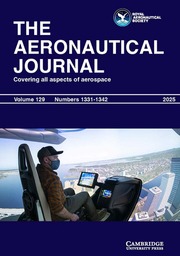Article contents
The aerodynamics of the compound helicopterconfiguration
Published online by Cambridge University Press: 04 July 2016
Abstract
A computational method has been developed toinvestigate the aerodynamic interaction between ahelicopter rotor and the fuselage in steady-statelevel forward flight. In order to model a compoundhelicopter the fuselage is fitted with wings. Themodel uses deformable vortex rings for the rotorwake, a source panel representation of the fuselageand a lifting surface method for the wings which canhandle arbitrary geometries. The wake representationis based on a free wake analysis, relaxing the nodalpoints on the vortex rings and wing wake elementsaccording to the induced velocities in the flowfield after every time step. In this way, neitherwake is restricted to planar shape. At each timestep the fuselage and wing forces were calculated.The trim attitude of the fuselage was determined bythe pressure field surrounding it using a potentialflow model for the external flow and a fullydeveloped turbulent boundary layer model on thefuselage surface. Parametric studies were carriedout to determine the influence of wing position,wing span, wing angle of incidence and advance ratioon the results. The computer program incorporates agraphical postprocessing output routine allowing thevisualisation of the wake shape, the inducedvelocity and the angles of incidence on the rotordisc to be made, together with the velocities atvarious wing stations and the lift coefficientsalong the span.
Information
- Type
- Research Article
- Information
- Copyright
- Copyright © Royal Aeronautical Society 1996
Footnotes
formerly University of Stuttgart, Germany.
References
- 5
- Cited by

